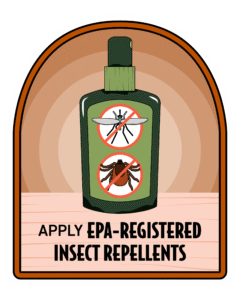Heather N. Kolich, ANR Agent, UGA Extension Forsyth County

Small agents in nature can have powerful consequences
Through large, visible events such as hurricanes, earthquakes, and tsunamis, nature reminds us of its power. Nature can also affect us through small and invisible agents, like insects and parasites. Insect bites and parasite infestations can have irreversible, lifelong impacts. For many of these, prevention is the only protection.
Bad actors in the bug world
Parasites are organisms that live on or inside other species, including humans, while feeding on the blood and tissues of the host. My first knowledge of parasites came as a kid when I heard horrifying news reports of an outbreak of trichinosis – a disease caused by eating undercooked pork and ingesting roundworms that burrow into muscle tissue. A microbiology course in college convinced me to never eat raw seafood. Among numerous parasites transmitted from undercooked fish is a tapeworm, Dibothriocephalus latus, that can grow 30-feet long.
Insects such as ticks and mosquitoes are ectoparasites. They feed on victims from outside the body by piercing or burrowing into skin. Internal parasites live and feed inside the body. Several internal parasites get in through the mouth (ingestion), while others burrow through skin. Hookworms, for instance, are parasites that borrow into the body through bare feet exposed to infected soil. From the foot, hookworms travel to the lungs, where they make you cough, then they get swallowed and move through the digestive system to the intestines. Hookworm larvae pass out of the body in feces to infect new hosts.

Some external parasites serve as vectors for diseases and internal parasites. When they bite an animal or bird to feed, parasites can ingest pathogens and then transmit those pathogens to other mammals and birds with a later bite. For example, mosquitoes can transmit viral diseases like Dengue fever, Zika, and West Nile virus, as well as the parasites that cause malaria and heartworm disease.
The Centers for Disease Control and Prevention (CDC) lists 15 diseases that ticks can transmit to people. These diseases are caused by bacteria, viruses, and parasites carried by blacklegged (deer) ticks, lone star ticks, and American dog ticks, all of which are present in the Eastern U.S. The early symptoms of most tick-borne diseases include fever and chills, headache and muscle aches, nausea and vomiting, and fatigue. In addition to these symptoms, Lyme disease, Rocky Mountain Spotted Fever, and Southern Tick-associated Rash Illness (STARI) cause skin rash.

Tick bites can also cause some people to become allergic to red meat. Known as alpha-gal syndrome (AGS), it is named after a sugar molecule found in most mammals. AGS is typically associated with bites from lone star ticks, but CDC studies indicate that the blacklegged tick may also trigger the allergy. Symptom onset may be delayed for several hours, but the condition is permanent and can be life-threatening.
For most diseases transmitted by ticks and mosquitoes, there is no vaccine and no curative medicine. Prevention is the recommended action.

Internal parasites include single-celled protozoa and multi-celled helminths known as flatworms, thorny-headed worms, and roundworms. Protozoa live in water, including freshwater lakes, ponds, rivers, and saltwater oceans. Between hosts, helminths live in soil contaminated with feces. Inside the host, internal parasites can live in and affect the gastrointestinal tract, muscle tissue, and the central nervous system. Larvae pass from host to host by eating raw or undercooked meat from infested animals and seafood, or from exposure to soil contaminated with the feces of an infected animal or person.
How to avoid and block parasites
We can apply knowledge and simple actions to protect ourselves from external and internal parasites.
Don’t go where ticks go. Ticks hang out in grassy, brushy, and wooded areas. They move to hosts from the ground or tall grasses and then climb upward seeking exposed skin.
Remove mosquito habitats. Mosquitoes lay eggs in standing water, and even a little bit of water can be mosquito larvae habitat. Clean up all debris around the yard and drain water from planter trays, garden carts, tarps, outdoor furniture, and toys after every rain. Use mosquito dunks or granules containing Bacillus thuringiensis subspecies israelensis (Bti) in rain barrels and ditches that hold water.

Don’t give parasites an opening. When outdoors, wear light-colored, long-sleeved shirts and long pants to minimize skin exposure. Apply an EPA-approved insect repellent, such as DEET, IR3535, or Picaridin to exposed skin. In tick territory, tuck socks into boots, pants into socks, shirts into pants, and tighten sleeve cuffs around wrists to keep ticks from getting under clothing. Keep water from open sources away from your mouth and nose. Thoroughly wash hands after exposure to fecal material, soil, and lake or stream water before eating or touching your mouth or nose. Proper cooking destroys pathogens. Always thoroughly cook meat and seafood, as well as fresh produce that has been exposed to soil or water from open sources.